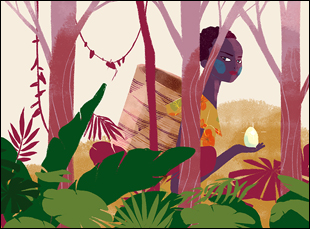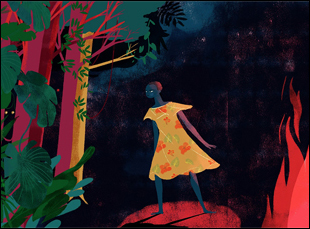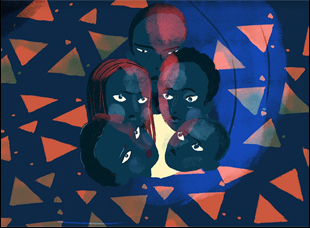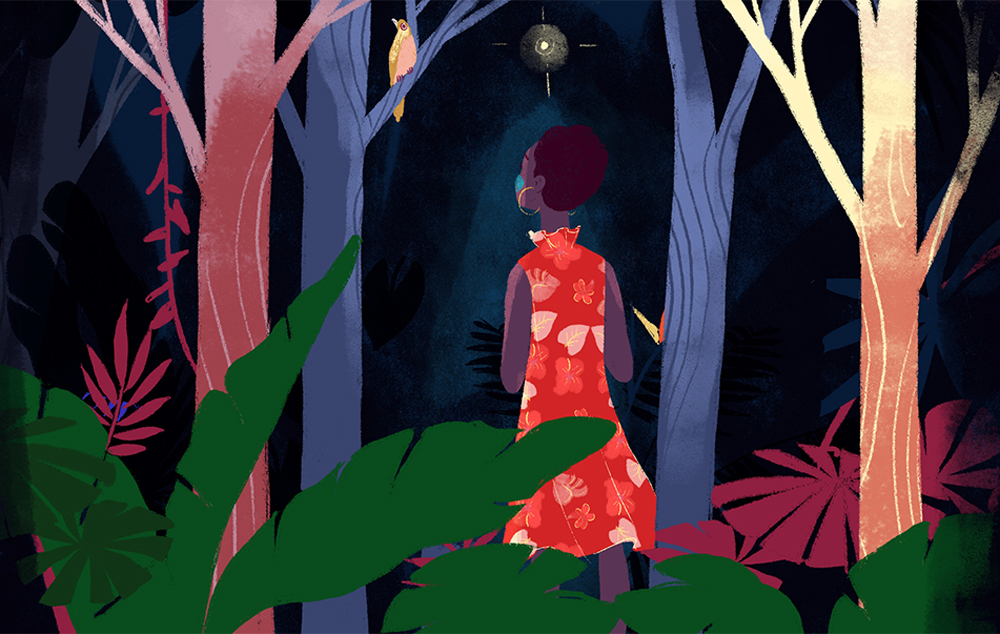When the home of Mugeni, the central subject of “More Than I Remember,” is set ablaze, part of a village that’s been burned to the ground by a local militia in the Congo, it feels as if the entire world is on fire. Vivid red outlined by black punctures the screen and as colorful as every frame of Amy Bench’s latest film is, it leaves nowhere to turn when any view of the path there and any way ahead has been overwhelmed by simply considering the moment at hand. While the sense of devastation is bound to hit immediately, the film’s florid depiction of Mugeni’s escape arouses all the senses as if survival depended on it, placing one in her shoes as she flees through a forest and through a series of unexpected events finds her footing in Michigan as a refugee.
A celebrated cinematographer, it might seem a bit unusual that Bench has now directed two animated shorts in what’s poised to be an ongoing series about those seeking asylum in an increasingly inhospitable world. But it was her work behind the camera that led her there, first filming with Syrians who had relocated to her home of Austin, Texas for a documentary project and being so moved by their testimony she was eager to tell more of their stories. She would realize this could actually be done more effectively if the people she talked to, often with relatives still living in fear of what violence could happen locally, didn’t have to worry about appearing on screen, leading to a breakthrough on her first directorial effort “A Line Birds Cannot See,” in which a young Guatemalan woman who goes by E.L. reminisces about the terrifying experience of navigating the streets of Ciudad Juarez as a 12-year-old after losing contact with her mother while crossing the U.S./Mexico border and sets out towards a reunion.
Sadly, there is all too much familiarity between the stories of E.L. and Mugeni, who is separated from her family in the village of Murambya and is moved around to two countries where she fears no one will speak her native Kinyamulenge or Swahili, first in Kenya and then in the U.S. However, there is an irresistibly refreshing quality in how Bench resets the conversation around welcoming the displaced into more stable nations, building upon the details in the direct testimony she captures to describe the largely unthinkable with a full-on embrace of animation and all its possibilities. Working with “The Shawl” animator Maya Edelman to create one disarmingly bold and breathtaking frame after another, Mugeni’s often frustrating two-year journey towards resettlement can be imagined at times as if it were an MC Escher painting and often employs color as a connective tissue when all other cultural commonalities can feel as if they’ve been lost.
It isn’t just the obvious sustenance that eggs can provide once Mugeni lands in America, but the feeling that their yellow yolk can summon from her youth and “More Than I Remember” proves true to its title when it goes beyond relating a memory to become a full-fledged immersion into the life of another. The film is all the more remarkable when considering it is just one of four that Bench will be premiering at South By Southwest this week, including her work as a cinematographer on “Shouting Down Midnight,” a profile in courage following Wendy Davis’ efforts to keep a woman’s choice legal in Texas; “Lover, Beloved,” a Suzanne Vega-starring musical; and the documentary “Mama Bears.” Quite graciously, the filmmaker somehow found the time to talk about “More Than I Remember,” which she invested as much time and energy as any of the features, if not more and she spoke about the process and a dedication to authenticity that yields such emotionally insightful films.

After making “A Line Birds Cannot See,” I recognized the impact and the importance of telling these stories from a female perspective. A lot of their lives are impacted by the violence brought about by the men beyond their control, so I’m compelled to share the stories of the women that are prevailing despite all of that violence and also help contribute to the dialogue to give voice to the immigrants that come to this country [so others] recognize how important it is that we embrace people coming to this country for refuge. I was actually working with another subject from South Sudan on a second film, but because of COVID and other things, I had to put that project on hold. I had met Mugeni in December of 2019 and in talking with my producer Carolyn Merriman, we decided to make this film the second.
I knew Mugeni’s story was interesting when I first met her. There’s three resettlement agencies that work with children that are unaccompanied refugee minors and I reached out to her resettlement agency Bethany Christian after reading a New York Times article about other children that had fled Myanmar and were making a life in Michigan, [though] they feared a lot of guilt that they were able to escape while their families were surviving as refugees in foreign lands. The children in this piece were boys and I really wanted to make a film about a girl, and [Bethany Christian] suggested a couple of women. One of them was Mugeni, so I knew a little bit about her story before we decided to meet with her – I knew she had been separated from her family and had this really emotional reunification with her mom after five years.
How did animation become appealing as a form to tell these stories?
For “A Line Birds Cannot See,” I was basically just doing audio interviews with women who came to the U.S., as I felt that using audio would be a way to capture and tell someone’s story without a security risk for them. Because a lot of people I was talking to early on had escaped a situation in their native country, and a lot of their family members had not, if the person chooses not to reveal their identity, that was totally fine and that choice can be made once the film is done. I was also usually working with translators, so I started the process using the audio recorder to keep things simple and unobtrusive. I found that I really liked working that way because it’s usually just me and it’s a lot easier to manage technically. I also like conversational nature around it and the sound of people’s voices in interviewing. Audio allows me to focus on that and also have a more intimate connection with them in a way I find much easier than if you have lights and a camera and a crew.
And there’s something about animation I really enjoyed after the first film that I decided I’m going to keep doing this process because it allows me to tell this story in the most clear, emotionally driven way possible. Then we can develop the visuals once the story is in place. And I really like working with animators. As a cinematographer, I’m not so used to collaborating with someone who’s creating visuals in the same way, so it’s a way for me to step back a little bit and work with someone who is really versed in visual language in a different medium.

As a female filmmaker, I’m always very intentional about who I work with and I enjoy working with other women and people of color and I was delighted to be able to work with all the different people that I did. I was actually looking for a female animator and even before I had my next project, I asked my friend Kristian Mercado, a talented filmmaker who often works in animation, who I should be looking at. Several months later, I was at DOC NYC with “A Line Birds Cannot See” and in the program, there was a short that Maya was the animation director on and I thought it was the most beautiful one in the program. I wanted to chat with her, but she fled after the Q & A, so I didn’t meet her. [laughs] But I reached out to her once we had decided to make this film about Mugeni and she agreed to work on the project as the animation director.
One of the reasons she wanted to work on the film was that she came to the U.S. as a refugee herself and I didn’t know that when I first reached out to her, I had an intuition that she could add something to the story and I think it definitely provides a depth that comes through in the film, especially in the scene where Mugeni comes back to the U.S. and she doesn’t know how to communicate with her family. I know Maya said that was something she strongly identified with as a child when you don’t have the words to communicate, but you so desperately want to and [Maya’s] just got a unique vision. I just love her unrestrained use of color and I just wanted to see what Maya would come up with. She’s like, “I just basically use any color I want.” [laughs] So I’m like, “Let’s go for it.”
Maya started storyboarding in May of 2020 and in collaboration with Carolyn, it took me a few months to come up with the final audio edit. Once we did storyboards, we were almost picture-locked, so we basically went through scene by scene and did one scene at a time and we didn’t animate the film in order. We focused on the more emotionally charged scenes first and then stepped backwards. It was really great working with Maya to map out the visual story and then I worked with a few animators who took the storyboards and the illustrations and did the animation. Maya helped me oversee that animation to see if there were any tweaks that we needed. Samia Khalaf is a female animator who worked with for a few months and then she had to leave and then I brought on Sebastian Bisbal, who I had met at SXSW in 2019. He’s from Chile and his grandparents were persecuted under Pinochet, so he also had that experience and it was important for me to bring in people who could identify with Mugeni at different levels.

Yeah, I think we got as much from Mugeni in terms of her personal experience as we could through the interview. She was just 14 at the time of the attack and had never left her village until that point, so her perspective is one of complete and total shock. She knew there were people that didn’t like her tribe. She heard bombs and warfare in the distance, but it was never in her village, so she knew there was maybe a subconscious, baseline level of fear. For the larger historical and regional context, I turned to Rukumbuzi Delphin Ntanyoma, an author, journalist and Ph.D student in the Netherlands I found through his online writing who is also Banyamulenge from the same area in the DRC. So all the audio is from the interview with Mugeni, but in order to make sure that the backgrounds and the clothing and everything was accurate, I worked with him throughout, from the storyboard phase to the end title cards.
We did as much research as we could on our own and double checked things with Mugeni and Rukumbuzi. When I met Mugeni in Michigan in early 2020, we did an interview over two days and each day she just had a certain flair about her and I collected a lot of photos from [Mugeni’s] foster mom to see her various outfits. Her clothing was really unique and you could tell that she was interested in fashion. Maya was drawn to that, so all of her outfits in the film are based on that love of clothing that Mugeni has and for specific locations, I would Google her town and I would text [the images] to Mugeni and say, “Is this your village? Because sometimes it’s hard to tell if something from the Internet is correctly labeled. It was very small and there’s not a lot written about it, but I verified a few images were actually her village, so we used those as references for the opening of the film.
Then even before we did storyboards, Maya did basically character sketches of Mugeni and before we committed to one, I shared those images with her because it was important to me that she felt like this animated character represented her in a way that resonated. I checked in with her at [other] key moments, and she’s like, “Oh, I love it,” so it was pretty amazing.
What’s it like to get to the finish line with this?
This film was made entirely during the pandemic, so it does feel good to have accomplished something that day-to-day two years ago felt very difficult because I’m a mom with two kids who were at home for a long portion of the pandemic. Maya was living through the early stages of the pandemic in New York, and my brother died tragically and unexpectedly during the making of this film, so there were a lot of hardships that we went through personally and the fact that something that I hope moves people in a deep way and that we were able to make through our own hardships feels really satisfying. And I am amazed [generally by] the violence and conflict that has been going on for decades or even centuries. We’re seeing that type of unprovoked, all-out aggression by Russia in Ukraine right now. Sadly, the level of violence that’s going on in Eastern Congo feels largely unrecognized by the rest of the world, so I’m hoping that this story can shed more light on that and that we can not only embrace more refugees in the United States, but address the situation in Congo because nobody seems to be able to figure that out yet and that this film can be part of that.
“More Than I Remember” will screen at SXSW as part of the Texas Shorts Program on March 11th at 8 pm at the Austin Convention Center and March 15th at 3:15 pm at the Rollins Theatre at the Long Center. It will also be available virtually beginning March 12th with a SXSW Online badge.




